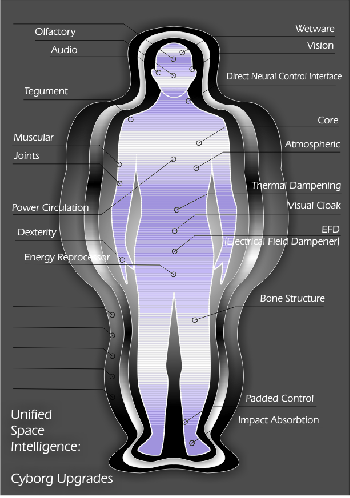Difference between revisions of "Tech:Cybernetics"
| Line 68: | Line 68: | ||
====Muscle and bone crafts==== | ====Muscle and bone crafts==== | ||
| + | A typical application of cybernetics. Muscles are augmented by electromuscle filaments and bones with protective layers of carbon nanofiber tubes. If larger boost in performance is required, muscle cells are replaced with clone-grown gene-tailored muscle cells and the amount of electromuscle filaments increased. Eventually muscle tissue is entirely replaced. | ||
| + | The increased muscular strength requires a corresponding increase in skeletal structure strength to prevent the power of the muscles damaging the body. Even if your new augmented musculature is strong enough to lift a cargo container, if the weight crushes your bones to splinters it will amount to little. Thus while the muscles are augmented, the same goes to the bone structure. Bones are gradually replaced with lightweight but strong carbon nanofiber tubes, or in more extreme cases with lightweight metallic alloys. Still, a person’s bodyweight will be increase significantly during the augmentation; a full-conversion muscle and bone crafts are likely to add from 100 to 300 lbs to a person’s weight, depending on the person’s size and the extent of the augmentation. | ||
====Enhanced senses==== | ====Enhanced senses==== | ||
Revision as of 09:39, 8 May 2007
Contents
Background
Cybernetics is the science of combining a man with a machine.
Begun as crude attempts to create processors that would be able to interface with a living being’s nervous system, to translate a computer’s commands into nerve impulses that would stimulate the senses and fool the muscles into action, it was the discovery of a technique to grow nerve cells on silicon chip base that allowed cybernetics to transcend from fiction into fact. With the physical bridge between computer and living tissue now established, decoding the language of the neurons was merely a matter of time and processing power. Later, miniaturization through the application of nanotechnology allowed cybernetics to leapfrog from specialist industry into mainstream society.
First used in the creation of artificial limbs and organs, the application of cybernetics were soon expanded to augmenting people’s physical and mental functions, as well as providing useful abilities people had previously needed external appliances for. Boosted muscles and reinforced bones, senses heightened beyond what nature had intended. Accelerated reaction speed, heightened immune system to fight off diseases genetics have not yet found a cure and to quickly recover from injuries. Processor and memory nodes to augment the brain, wireless communications links to replace communicators and allow the augmented to connect to the local Cyberspehere (See link) and to remote-control appliances and vehicles.
The natural next step was for programs to be downloaded and ran in the processor nodes, giving a person the ability to, for example, record a corporate meeting through his own senses into a secure memory node while agent programs datamined the Cybersphere and company databases to provide additional information. All this while the person himself could devote his attention to the matter at hand, digesting the data provided by the agent programs to better understand the topics discussed.
Military applications
Military quickly understood the benefits of cybernetics and indeed armed forces were most often at the cutting edge of the technology, trying out all possible methods of improving the survival rate and effectiveness of its top agents. Cerebral re-engineering, war-drug dispenser implants and axon blocks provided lightning-quick reaction rate and relative immunity to pain, augmented muscles and skeletal structure made lifting massive weights possible.
Nano-fibers threaded into skin layers provided adequate protection from harm, and internal force-field webs, despite their massive power consumption rates, turned even apparently unarmed and unarmored troopers into deadly weapons. Thermal shunts and active stealth coating in the form of active chameleon pigmentation of the skin allowed the augmented troopers to evade enemy sensors, while heightened senses and implanted sensors gave them the ability to spot their targets with pinpoint accuracy.
Wetwired weapons controlled by thoughts alone, weapons that forwarded targeting information directly into their user’s brain and implanted weapons like miniature particle energy weapons and nerve-jammers, monofilament garrottes and mono-bonded carbon claws were soon to follow, literally turning the heavily augmented troopers into living weapons.
The logical next step in the heating cybernetic arms race was the introduction of full-conversion cyborgs; people whose brain and spinal cord were removed from their bodies, sealed in life-support container and installed in a fully artificial bodies. Eagerly experimenting with their ever improving super-soldiers, the scientists realized that at this point there was no reason to limit their soldiers to humanoid bodies; four legs offered greater stability in difficult terrain, four arms could carry and operate more weapons systems at the same time. Mobility was augmented via replacing limbs with electromuscle tentacles, senses were boosted by replacing eyes with omnidirectional sensor bands. Only a minority of the augmented proved willing to lose their humanity to that degree, hanging on to the belief that the human shape and human thoughts still made them humans in truth, but the few that were willing to go any length in their quest for personal power surpassed their augmented colleagues like they had surpassed the unaugmented.
The dark side of cybernetics
It was the military that was first introduced to the dark side of cybernetics; the mental symptoms nearly every individual displayed after certain level of augmentation was reached. The disease was elusive, striking some individuals early, almost after the first augmentations were installed while others showed no noticeable signs even years after a measurable portion of their bodies had been replaced with cybernetic implants. The symptoms themselves were as varied as much as the onset time of the disease, from mood swings to progressive personality changes, from paralysis to paranoia, from hallucinations to bouts of explosive violence. Death was all too often the final stage of the disease, whether through antisocial behaviour that leads to violent death or the slow decline of a progressive, degenerative collapse of the nervous system. The killer with the many faces soon found a name; Cyberpsychosis.
The actual base cause of cyberpsychosis was debated for long. Bacterial infection of subcortical and limbic structures of the nervous system. Metal poisoning interfering with the cerebral cortex. Neurotransmitter imbalance. Over the decades the last option began to gain in support; people who had augmented their brain and their nervous system were the ones who fell to the psychosis faster than those who had only augmented their bodies.
Treatment of cyberpsychosis is possible, but the road to recovery is long and hard. The approved method consist of removal of all cyberware and administration of antipsychotic medication. The removal of the augmentations helps restore the faded body-image of the patient, but the effects have been noted as minor; still, the benefit lies in minimizing the chance of the patient’s condition worsening and ensuring the safety of the medical personnel treating the patient. Psychological therapy is usually attempted after the patient’s condition has begun to show signs of improvement, but the results have been generally poor. All in all, full recovery from the psychosis is all but impossible and the chance of a patient becoming a productive member of his society even after years of intense therapy and heavy medication is less than 50%.
The nations of cyborgs
The terror of cyberpsychosis was a devastating blow to the industry. Even the armed forces began to slow down the augmentation of their troopers; were the admittedly massive benefits worth the risk of an augmented soldier going berserk in the middle of the mission or in training? With the latest weapons hardware the augmented were capable of laying waste to whole companies of regular soldiers. After a few near-disasters that showed the reality of the threat, laws were passed that regulated the augmentation of humans, requiring hard-to-acquire permissions and medical statements from doctors to have anything but the most basic Cybersphere links installed.
A certain culture-subgroup, though, was drawn to the idea of expanding their bodies and mentalities though a symbiosis with machinery and rebelled against the limitations imposed on them by society. Add to this the fact that those already augmented became persecuted, the unaugmented treating them as disasters waiting to happen. Thus it was inevitable that once the Cyborg Faction was established by a group of renegade military cyborgs, many of the augmented saw this as an answer to their prayers. Soon, though, differences in opinions and in political ambitions saw the single Faction breaking up into numerous splinter Factions, each independent and free to pursue their own goals.
Over the decades, medical scientists in the Cyborg Factions continued their studies into cerebral cortex re-engineering surgery and eventually found a cure for cyberpsychosis, the greatest threat to their continued existence. The scientists learned that certain surgical alterations to the brain significantly reduced a person’s chances of succumbing to the psychosis, and while the operation wasn’t without its risks (Permanent personality changes, the loss of perceived “humanity”) the treatments quickly became widespread inside the Faction. The technology was never openly offered for the use of other Factions, and considering the known side effects, it might not have been accepted in any case. The other factions moved to develop their own solutions, and while they were universally markedly less effective, they were non-invasive enough to be accepted by the societies at large and were effective enough to allow low-level augmentation of their citizens to be resumed.
Cybernetics in the Universe
Cybernetic augmentations can be done to virtually any part of the body, and are divided into the following categories and subcategories:
Wetware
The general term for cybernetics that directly augments the brain and the nervous system. Wetware augments are the number one known cause of Cyberpsyschosis amongst most Cybernetically augmented.
Processor nodes
Memory cells
Reflex boosters
Stress response management
Network implants
Skill memories
Utility software
Anti-intrusionware
Bodyware
The general term for cybernetics that augments the body’s physical attributes.
Muscle and bone crafts
A typical application of cybernetics. Muscles are augmented by electromuscle filaments and bones with protective layers of carbon nanofiber tubes. If larger boost in performance is required, muscle cells are replaced with clone-grown gene-tailored muscle cells and the amount of electromuscle filaments increased. Eventually muscle tissue is entirely replaced.
The increased muscular strength requires a corresponding increase in skeletal structure strength to prevent the power of the muscles damaging the body. Even if your new augmented musculature is strong enough to lift a cargo container, if the weight crushes your bones to splinters it will amount to little. Thus while the muscles are augmented, the same goes to the bone structure. Bones are gradually replaced with lightweight but strong carbon nanofiber tubes, or in more extreme cases with lightweight metallic alloys. Still, a person’s bodyweight will be increase significantly during the augmentation; a full-conversion muscle and bone crafts are likely to add from 100 to 300 lbs to a person’s weight, depending on the person’s size and the extent of the augmentation.

